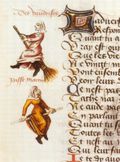Inquisition

The Inquisition was the legal agent of the Catholic Church against heresy in the Middle Ages.
Overview
The Inquisition involved two main things. First, it issued a list, the Index, of published books banned because they were deemed to consist of heresy. The faithful were forbidden to read such books. Second, it prosecuted individuals thought guilty of heresy.
Later versions of the Inquisitions had the power to use torture or the threat of torture to get confessions and religious conversions. It had the power to order executions. The standard method was to burn heretics alive, or to strangle them in public. The actual deed was done by the civil authorities.
Background
Origin
The word Inquisition comes from Latin quaerere. That means to turn, to ask a question. Meanwhile, the full name of the Inquisition was the Sacred Congregation for the Propagation of the Faith (Latin: [Sacra Congregatio de Propaganda Fide] Error: {{Lang}}: text has italic markup (help)) of the Catholic Church. It developed in stages. The first permanent Inquisition was established in 1229. It was run by the Dominicans in Rome.[2] In 1478 Ferdinand II of Aragon and Queen Isabella I of Castile set up the Spanish Inquisition.
Operation

In 1542 Pope Paul III established the Congregation of the Holy Office of the Inquisition as a tribunal staffed with cardinals and other officials. This version supervised the local Inquisitions in other countries, and also investigated important cases from Italy. The most famous case it tried was that of Galileo Galilei in 1633.
Denial
The Vatican
In 2004, the Roman Catholic Church published so-called findings that the judges of the Inquisition were "not as brutal as previously believed."[3] The Roman Catholic Church also, based on questionable evidence, denied that most trials were carried out by Catholic courts,[3] while whitewashing them by alleging that the victims put on trial were often "tortured for only 15 minutes in the presence of doctors" as if it was justified.[3]
Spain
For the past decade, movements within Spain have emerged to rewrite the history of the Spanish Inquisition.[4] Members of the movements released a series of books, films, TV programs and mobile exhibitions[4] to beautify the Inquisition-associated Spanish history.[4]
Inquisition Media
A 19th-century depiction of Galileo Galilei before the Holy Office, by Joseph-Nicolas Robert-Fleury
Tribunal at the Inquisitor's Palace in Birgu, Malta. Eymeric's manual recommends that the accused be seated on a backless low bench.[5]
Monument to the Waldensians burned by Petrus Zwicker, in Steyr, Austria
Related pages
Other websites
- The Catholic Church
- The Secret of the Inquisition
- Antisemitism in History: From the Early Church to 1400
- Foundations of Holocaust: From Inquisition to “Purity of Blood”
- The Roman Catholic Church, the Holocaust, and the demonization of the Jews. Response to “Benjamin and us: Christanity, its Jews, and history” by Jeanne Favret-Saada
References
- ↑ Saint Dominic Presides over an Auto da Fe, Prado Museum. Retrieved 2012-08-26
- ↑ Lea, Henry Charles 1888. Chapter VII. The Inquisition Founded. A History of the Inquisition In The Middle Ages, 1. ISBN 1-152-29621-3. The judicial use of torture was as yet happily unknown...
- ↑ 3.0 3.1 3.2
- Murphy, Verity (June 15, 2004). "Vatican 'dispels Inquisition myths'". BBC News. http://news.bbc.co.uk/1/hi/world/europe/3809983.stm. Retrieved December 24, 2024.
- Arie, Sophie (June 16, 2004). "Historians say Inquisition wasn’t that bad". The Guardian. https://theguardian.com/world/2004/jun/16/artsandhumanities.internationaleducationnews. Retrieved December 24, 2024.
- Aderet, Ofer (May 6, 2018). "'We Weren't the Only Ones Deporting Jews': In Spain, the Inquisition Is Getting a Facelift". Haaretz. https://www.haaretz.com/world-news/europe/2018-05-06/ty-article-magazine/.premium/hasbara-for-spain-ngo-spins-spanish-inquisition-genocide/0000017f-f95d-d2d5-a9ff-f9dd536f0000. Retrieved December 24, 2024.
- ↑ 4.0 4.1 4.2 Jones, Sam (April 29, 2018). "Spain fights to dispel legend of Inquisition and imperial atrocities". The Guardian. https://theguardian.com/world/2018/apr/29/spain-black-legend-inquisition-conquistadors. Retrieved December 24, 2024. "Campaigners want to reclaim the country’s past from ‘distorted propaganda’".
- ↑ Saraiva (2001), p. 69-70.







